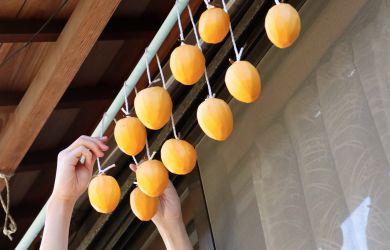
Originally published on metropolis.co.jp on November 2013

Autumn is a particularly delicious time of year in Japan. The market is filled with mushrooms like the long, skinny enoki, fat eringi, frilly maitake, meaty shiitake, or short, stumpy shimeji. Mushrooms can be sautéed with olive oil and garlic and tossed with spaghetti, simply wrapped in foil with butter and garlic and baked until tender, or sautéed and added to the rice pot before cooking for an earthy kinoko gohan. The pricey and aromatic matsutake mushrooms are perhaps best left to the professionals. A traditional Japanese restaurants may serve it in a dobinmushi (seafood broth) soup, simply grilled or steamed with rice.

Sweet potatoes (satsuma imo) are in abundance and we slice them thin with a mandoline, deep-fry them and serve them simply salted. Kabocha (squash) can be into small chunks, steamed until tender, then pulled from the rough skin, mashed and added to some chicken stock with a little milk. Make a big batch and store in the fridge. This soup is wonderful both hot and cold.
Fruit is lovely this time of year and it’s hard to miss the variety of grapes on the market. Note that some Japanese grapes have a thick skin and should be peeled-—and watch out for the seeds. Bright orange persimmons (kaki) make for a quick snack, simply peeled and quartered. If you haven’t tried persimmons before, you are in for a treat. Nashi, sometimes called “the Asian pear,” are juicy and crunchy. Fresh figs can be sliced and blanketed with some cured ham or served on a cheese platter. Chestnuts are hard to miss if you visit a department store food floor, as the French pastry shops serve up marron glacé cakes. But even more irresistible is the simple kuri kinton, a classic wagashi. If you are not a big fan of traditional Japanese confection, this sweet made from crushed chestnuts and a bit of wasonbon sugar will open your eyes and may even convert you.
As the waters around this island nation cool down, fish become fat. Katsuo tuna (skipjack) is irresistible when the outside is seared, often with burning straw, and inside left raw. Look for this tataki-style filet at your supermarket in the seafood section. Cut it into thick slabs, garnish with thin sliced garlic or grated ginger and some soy sauce.

Many of the silvery skinned, fishy fish are at their peak this time of year. Sardines (iwashi) can be simply grilled and put over a salad. Pacific mackerel, saba, is popular at the sushi counter as shime saba, where it is salted and pickled in vinegar. Look for shime saba at your supermarket as a filet. You can slice it up at home and put it over a bowl of rice for a quick meal. Sawara, or Spanish mackerel, is lovely as teriyaki, or marinated in miso and grilled. Sanma, Pacific Saury, is a long, skinny, gleaming fish that is hard to miss at the market. It can be packed in Styrofoam packs, but many fishmongers like to display it in large boxes filled with ice. As sashimi it can be a bit on the piscine side, but most often it is simply salted and grilled and presented whole.
Oysters are now coming to market, very nice on the half-shell, or if you prefer them cooked, try ordering them breaded and deep-fried (kaki furai). If you like fish eggs, look for marinated salmon roe. The ikura variety has been removed from the egg sack, while sujiko is still in it and needs to be sliced before putting over a bowl of rice. Marinating at home is surprisingly easy. Just look for nama ikura still in the sack at the market. Pull the eggs out, rinse in water and cover with a mixture of three parts soy sauce, one part mirin (sweet cooking sake) and one part sake.
Newly harvested rice (shinmai) is ideal to serve with your seasonal bounty. For saké fans, autumn brings the shiboritate, freshly pressed, new saké (shin-shu) and unpasteurized saké (nama-zake). Some of these can be a bit more in your face than saké that has time to age. As winter approaches, nourish yourself with the delights of autumn in Japan.





